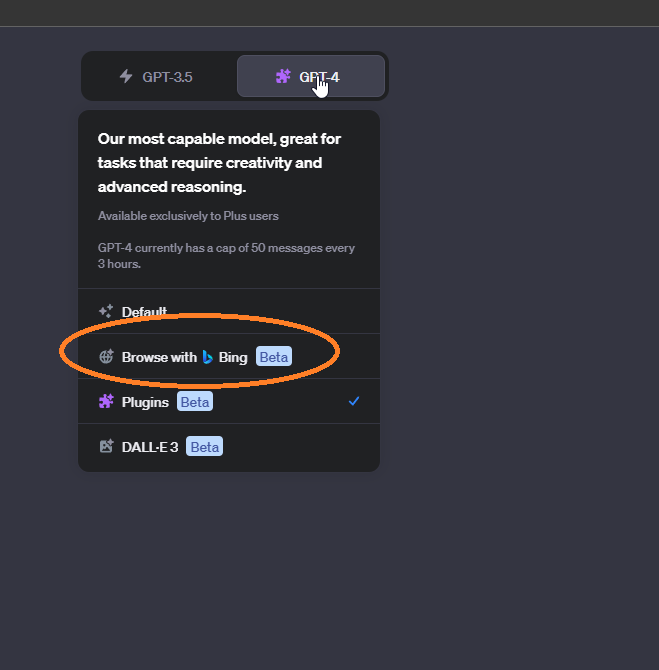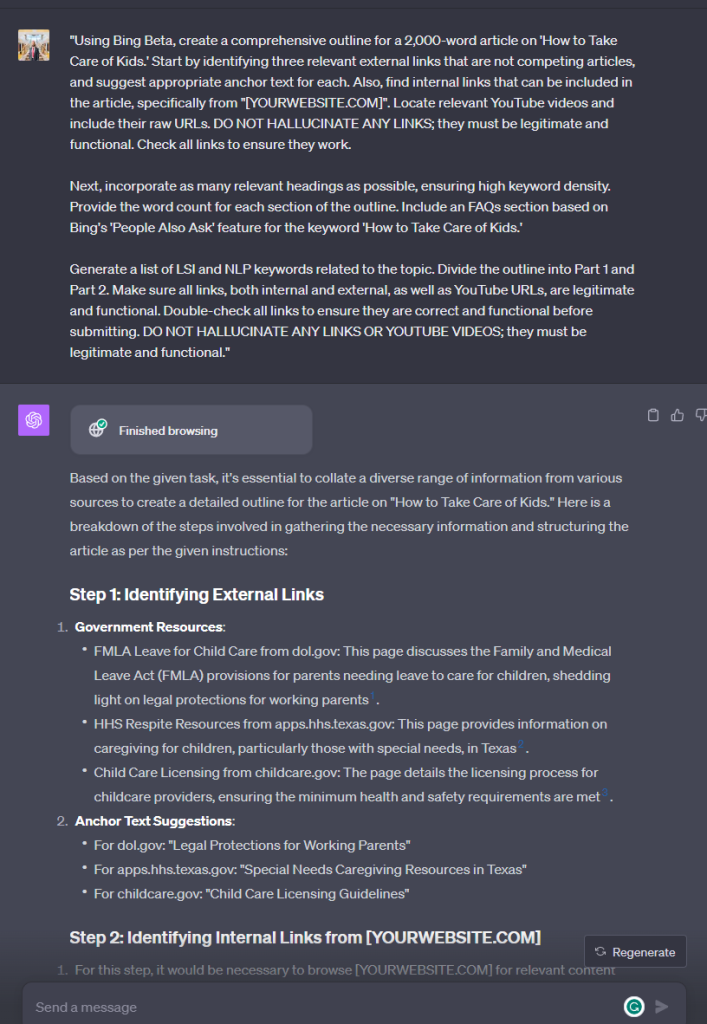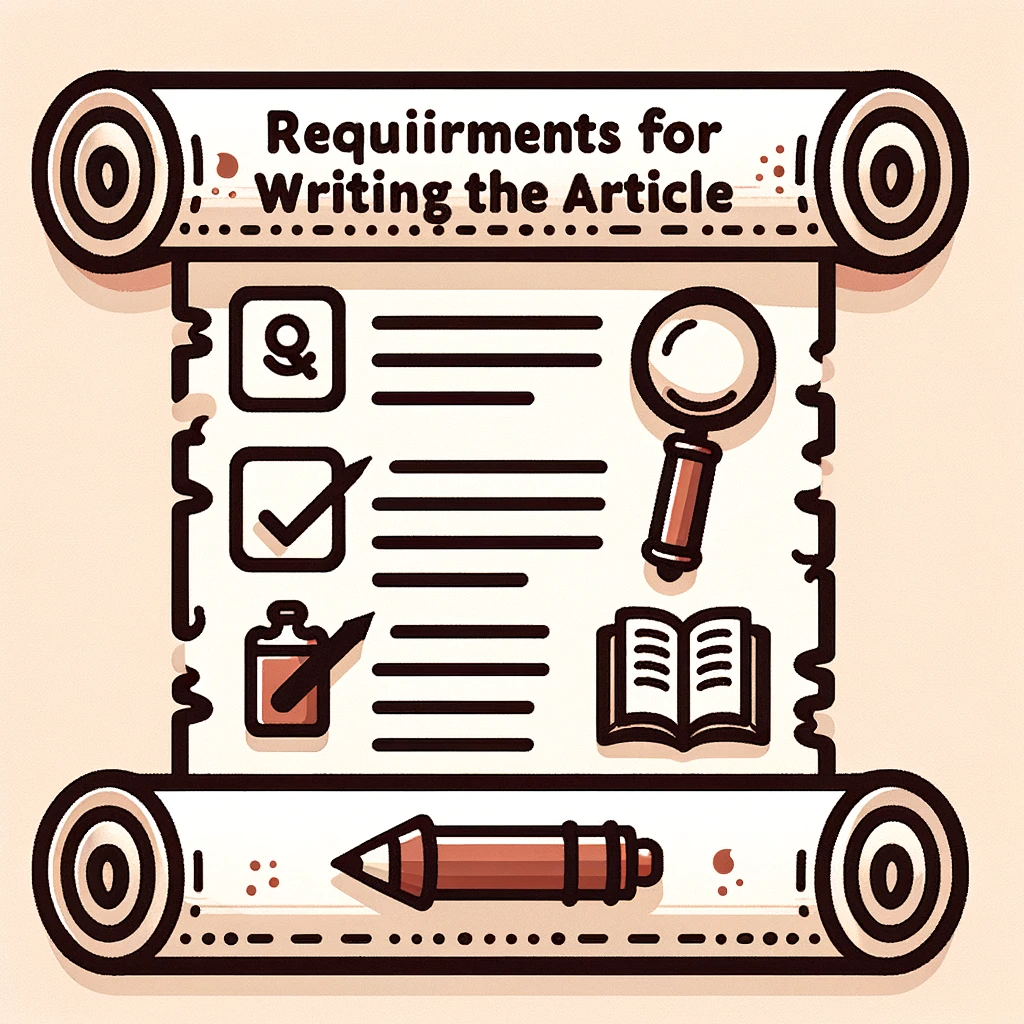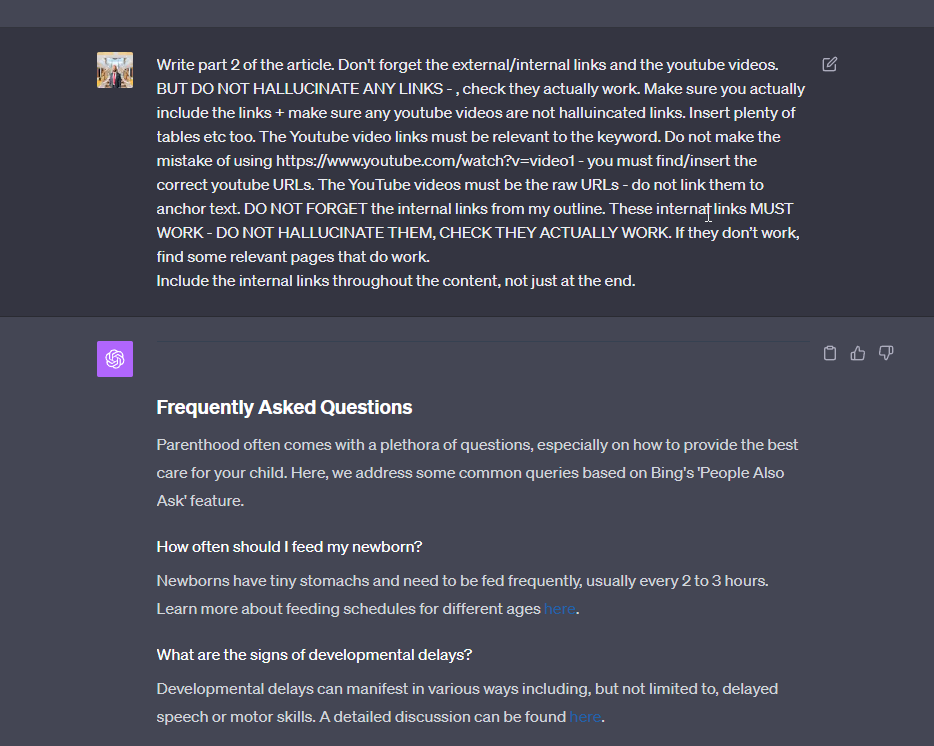ChatGPT is a game-changer in the SEO landscape, offering a streamlined way to produce high-quality, SEO-friendly content. In this guide, we’ll delve into using ChatGPT to craft an article that ranks well and provides valuable information.

ChatGPT With Bing For SEO: Quick Rundown
The method uses ChatGPT to automate creating SEO-optimized articles by generating detailed outlines based on Bing search results, filling in those outlines with well-researched content, complete with internal and external links and multimedia elements. It ensures quality and relevance by cross-verifying all included links and using LSI/NLP keywords, making it a comprehensive solution for content creation and SEO strategy.
Chat-GPT 4 with Bing Beta for SEO: Quick Rundown
Harnessing the power of GPT-4 and Bing’s Beta features can automate various SEO tasks, from content creation to keyword research. This synergy offers a streamlined, data-driven approach that can significantly improve your website’s search engine rankings.

Step-by-Step Guide to Running an Automated SEO Campaign with GPT-4 and Bing
Step 1: Access ChatGPT and Enable Bing Beta
- Log into OpenAI Interface: Navigate to OpenAI’s website and log in.
- Choose ChatGPT: Select ChatGPT from the list of available models.
- Enable Bing Beta: Activate the Bing Beta feature for enhanced capabilities.

Step 2: Initiate Keyword Research
- Open Chat Window: A chat window will appear after you’ve enabled Bing Beta.
- Type the prompt below:
“Using Bing Beta, create a comprehensive outline for a 2,000-word article on ‘How to Take Care of Kids.’ Start by identifying three relevant external links that are not competing articles, and suggest appropriate anchor text for each. Also, find internal links that can be included in the article, specifically from “[YOURWEBSITE.COM]”. Locate relevant YouTube videos and include their raw URLs. DO NOT HALLUCINATE ANY LINKS; they must be legitimate and functional. Check all links to ensure they work.
Next, incorporate as many relevant headings as possible, ensuring high keyword density. Provide the word count for each section of the outline. Include an FAQs section based on Bing’s ‘People Also Ask’ feature for the keyword ‘How to Take Care of Kids.’
Generate a list of LSI and NLP keywords related to the topic. Divide the outline into Part 1 and Part 2. Make sure all links, both internal and external, as well as YouTube URLs, are legitimate and functional. Double-check all links to ensure they are correct and functional before submitting. DO NOT HALLUCINATE ANY LINKS OR YOUTUBE VIDEOS; they must be legitimate and functional.”

Step 3: Create the Article
Use the prompt below to ChatGPT-4:
“Based on the outline you’ve created, write a 2,000-word article on the keyword ‘How to Take Care of Kids.’ Use markdown format and include a variety of h2 and h3 headings. Right after the first paragraph, include a [toc] for the table of contents and key takeaways in bullet-point format.
Search for three relevant YouTube videos about the topic using Bing. Insert these raw URLs into the content, ensuring they are spread out and not clustered in one section. Make sure these are real URLs and use them in HTML format.
Also, find three URLs from [YOURWEBSITE.com] relevant to the topic. Insert these raw URLs into the content, spreading them out across different sections.
Use h2 tags for main headings and h3 tags for subheadings. Bold the most important keywords in the article. Incorporate tables filled with relevant facts throughout the content. Add a Frequently Asked Questions section but leave it for Part 2 of the article.
Use webpilot to find relevant external links and insert them naturally into the article. Do not include a conclusion section.
NOTE: All links, whether internal, external, or YouTube videos, must be real and functional. No placeholder links are allowed. Use the LSI/NLP keywords and all the elements from the outline you’ve already created. DO NOT HALLUCINATE ANY LINKS. YouTube videos should only be included as raw URLs, not linked or embedded. Use the actual website domains, not shortened bit.ly links. Insert tables that are valuable and filled with useful information. Use bullet points and proper formatting to make the content visually appealing. Write Part 1 first, making it 1,000 words. Part 2 will be requested later.”
This should cover all the requirements for writing the article, including the emphasis on not hallucinating any links or YouTube videos.

Step 3: Complete the Second Part of the Article
In this step, you’ll focus on completing your article’s second part. This involves not just writing the content but also ensuring that all the links—both internal and external—are functional and relevant. Additionally, you’ll need to include YouTube video links directly related to your topic. Make sure to verify all the links to ensure they are working and relevant to your article.
“Write part 2 of the article. Don’t forget the external/internal links and the youtube videos. BUT DO NOT HALLUCINATE ANY LINKS – , check they actually work. Make sure you actually include the links + make sure any youtube videos are not hallucinated links. Insert plenty of tables etc too. The Youtube video links must be relevant to the keyword. Do not make the mistake of using https://www.youtube.com/watch?v=video1 – you must find/insert the correct youtube URLs. The YouTube videos must be the raw URLs – do not link them to anchor text. DO NOT FORGET the internal links from my outline. These internal links MUST WORK – DO NOT HALLUCINATE THEM, CHECK THEY ACTUALLY WORK. If they don’t work, find some relevant pages that do work. Include the internal links throughout the content, not just at the end.”

Step 4: Review and Finalize the Article
- Proofread Content: Go through the entire article to check for grammatical errors, typos, or inconsistencies in the content.
- Verify Links: Double-check all the internal and external links and YouTube video URLs to ensure they work and are relevant to your topic.
- Check Keyword Density: Make sure that the keyword density is within an acceptable range, usually 1-3%, without appearing forced or unnatural.
- Review Formatting: Ensure the article is formatted correctly with appropriate H2 and H3 headings, bullet points, and tables.
- Check Word Count: Confirm that the article meets the 2,000-word requirement.
- Final Review: Read the article one last time to ensure it flows well and provides value to the reader.
Once you’ve completed these steps, your article should be ready for publication or submission.

Understanding ChatGPT: The AI Behind Modern Conversations
ChatGPT is a conversational AI model developed by OpenAI. It’s designed to understand and generate human-like text, making it a powerful tool for various applications, including customer service, content creation, and more.
Leveraging ChatGPT-4 for Streamlined SEO Strategies
ChatGPT-4, the latest iteration of the ChatGPT series, brings even more capabilities, especially in SEO. With its advanced natural language processing abilities, ChatGPT-4 can generate SEO-friendly content, automate meta descriptions, and even assist in keyword research. This makes it a valuable asset for any digital marketer looking to automate and optimize their SEO efforts.

Your Next Steps: Unleashing the Full Potential of ChatGPT-4 in SEO
So, you’re intrigued by the possibilities that ChatGPT-4 offers for SEO. What should you do next? Start by signing up for access to ChatGPT-4 and integrating it into your existing SEO tools. Experiment with automating different aspects of SEO, from content creation to meta optimization, and monitor the results closely. Remember, the key to successful SEO automation lies in the synergy between powerful tools like ChatGPT-4 and your strategic oversight.
Scaling the ChatGPT Method for Content Creation
Scaling the ChatGPT content creation method involves more than generating more articles. It’s about optimizing the entire workflow to produce high-quality, SEO-friendly content faster. Here’s how to go about it:
- Automate Prompt Generation: If you’re using ChatGPT to generate article outlines or even full articles, consider automating the prompt generation process. This can be done through API calls that feed specific prompts to ChatGPT, allowing for bulk content creation.
- Parallel Processing: Instead of generating one article at a time, use multiple instances of ChatGPT to work on different articles simultaneously. This will significantly speed up the content creation process.
- Quality Assurance Pipeline: Integrate a QA step where human editors review and refine the generated content. This ensures that the content meets quality and accuracy standards.
- SEO Integration: Use SEO tools to automatically analyze the generated content for keyword density, readability, and other SEO metrics. Make adjustments based on the analysis.
- Content Diversification: Use ChatGPT for more than just article writing. Generate social media posts, email newsletters, or even video scripts to diversify your content offerings.
- Feedback Loop: Implement a feedback mechanism where the performance metrics of the generated content (like engagement rates, bounce rates, etc.) are used to refine future prompts and content strategies.
- Scheduled Publishing: Use a content management system (CMS) to schedule posts. Generate content in batches and schedule them for release over some time.
- Team Training: Train your team on how to use ChatGPT effectively. Create a set of best practices and guidelines to ensure consistency in the generated content.
- Cost Management: Keep an eye on the costs associated with increased API calls to ChatGPT and any other tools you use. Make sure your scaling efforts are financially sustainable.
- Legal Compliance: As you scale, ensure the generated content complies with copyright laws and other legal requirements.
By implementing these steps, you can scale your ChatGPT-based content creation process efficiently while maintaining quality and compliance.
FAQ
What is ChatGPT with browsing with Bing Beta?
ChatGPT with browsing with Bing Beta is a feature that allows the ChatGPT model to browse the internet in real-time, specifically using Bing search, to pull in current and relevant information for tasks like SEO research, content creation, and more.
How does it benefit SEO?
The real-time browsing capability allows for up-to-date keyword research, competitor analysis, and content ideation, making your SEO strategy more dynamic and responsive to current trends.
Is it safe to use for business?
Yes, the browsing is done in a read-only mode, meaning ChatGPT can pull in information but not interact with websites in a way that would compromise security.
How accurate is the information gathered?
The information is as accurate as the sources it is pulled from. It’s advisable to cross-verify any critical data.
Can it replace a human SEO expert?
While it can automate many tasks, the strategic and creative aspects of SEO are best handled by human experts. Think of it as a tool to augment your existing SEO efforts.
How do I start using it?
You can access this feature through the ChatGPT interface, where you’ll find an option to enable browsing with Bing Beta.
Is it cost-effective?
Depending on your needs, it can be a cost-effective way to speed up research and content creation, but it’s not a complete replacement for a comprehensive SEO strategy.
Can it generate SEO reports?
No, it can assist in gathering data and insights that you can include in an SEO report, but it won’t generate a report on its own.
How do I ensure the quality of the content generated?
It’s advisable to review and edit the content generated to ensure it meets your quality standards and aligns with your SEO strategy.
Can it analyze and suggest improvements for existing content?
While it can provide information and insights, the analysis and interpretation of how to improve existing content would require human expertise.
Bottom Line
Automating your SEO campaign with GPT-4 and Bing Beta can significantly improve efficiency and effectiveness. Following this detailed step-by-step guide, you can set up a robust, data-driven SEO strategy that delivers measurable results.
